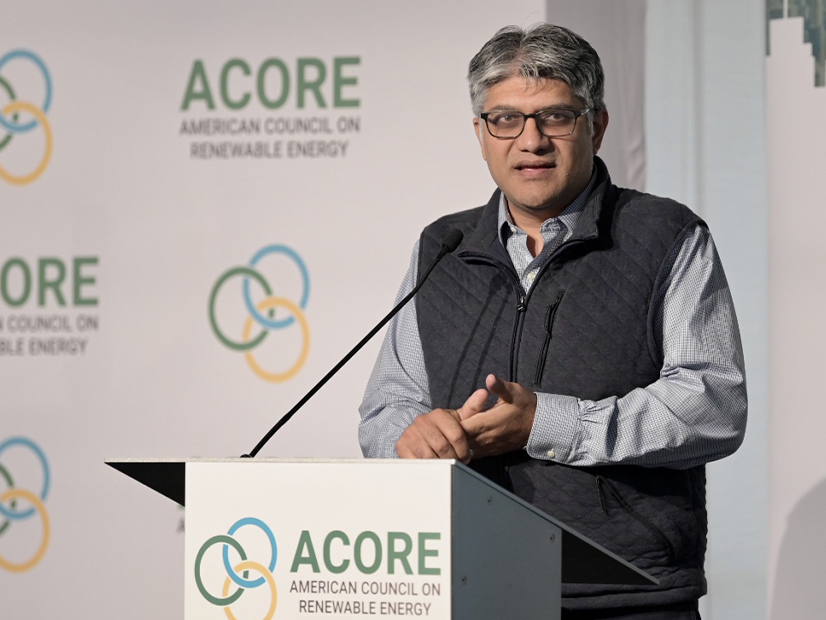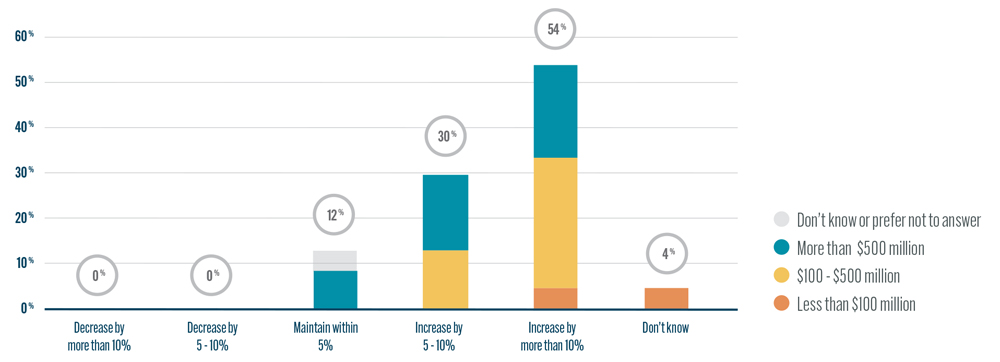
Though new federal incentives have made the U.S. increasingly attractive for clean energy investments, the industry suffers from a lack of ambition, the head of the Department of Energy’s Loan Programs Office told the American Council on Renewable Energy’s (ACORE) Finance Forum on Wednesday.
Faced with the massive financial incentives in the Inflation Reduction Act and challenges in permitting, transmission and supply chains, “there really isn’t a confident solution set to solving [these problems],” said Loan Programs Director Jigar Shah. “There is a modeling solution set. … We can model the crap out of everybody else, but the level of ambition that we have in this industry around actually taking control of our future is very low.”
Zeroing in on interregional transmission, Shah pointed to the industry’s “affliction … around believing that if we actually present a fantastic idea with a really good report, that someone’s going to read it and fix the problem for us.”
“It’s not that people don’t recognize the value of interregional transmission; it’s not that people don’t recognize the value of the offshore wind grid that would be built from Boston to New Jersey,” he said. “Clearly, there’s somebody who’s not wanting to do it, and so the question is who doesn’t want to do it? Why do they not want to do it, and what can you offer them to get them to do it?
“That’s the game,” Shah said. “That’s what it’s like to be at the big-boy table.”
Shah’s challenge to the developers and investors at the ACORE event in New York comes as the IRA has made the U.S. a focus for clean energy investment. A new report from ACORE released Wednesday shows that companies are spending more on new projects and, in some cases, risking more to take them on.
 More than half of the companies surveyed by ACORE are planning to up their clean energy investments by more than 10% this year. | ACORE
More than half of the companies surveyed by ACORE are planning to up their clean energy investments by more than 10% this year. | ACORE
While investments in renewables dipped slightly in 2022, more than half of the companies surveyed for the ACORE report said they would be upping their spending in the sector by more than 10% this year. On risk, the results were more divided, with 37% saying they would be moderately increasing risk and 32% moderately decreasing risk, reflecting industry concerns with “headwinds,” such as inflation, supply chains and permitting.
But the survey found universal agreement that the IRA has made the U.S. a major magnet for clean energy investment. ACORE CEO Greg Wetstone noted that for the first time in the six years of the organization’s annual finance survey, “virtually everyone we asked said that the U.S. would be a more attractive place for renewable investment compared to other countries” over the next three years.
Investors also ranked solar and storage at the top of a list of potential asset classes ripe for more investment. However, Wetstone cautioned, ”that doesn’t necessarily mean that’s where the investment is going to go. Storage has been near the top of this list for a long time, but the investment numbers have not been anywhere close to what we’re seeing in generation.”
Implementation Mode
The tension between industry optimism triggered by the IRA and ongoing economic and regulatory challenges was a theme throughout the opening panels at the event, and like Shah, other speakers called for the industry to focus on solutions.
Sandhya Ganapathy, CEO of EDP Renewables of North America, said her company could be committing more than 40% of its global capital to the U.S. renewables market.
“We now need to be in the implementation mode,” Ganapathy said. ”It’s a collective responsibility of the industry to actually sort of push ahead and see what are the challenges we have, make sure that we address those challenges and go ahead.”
“This is a time of optimism; this is a time of growth,” agreed Ingmar Ritzenhofen, chief financial officer of RWE Clean Energy, the U.S. arm of the German energy giant. “What’s crucial in this decisive moment is that we maintain the rational perspective on the things where we need solutions.
“We need to be clear [that] certain things don’t happen overnight. We cannot localize the entire supply chain overnight, even if we want to. … So, there needs to be a transition period; so, let’s have that conversation. I think that needs to be the mindset. How do we work through it? How do we resolve those things? And how do we deploy more?”
Project financing is a key part of the drive to increase deployment, and another point of risk and uncertainty for developers. The transferability provisions of the IRA will allow developers to sell their solar or wind tax credits to a third party, but the industry is waiting for the Internal Revenue Service to issue guidance on the provisions.
Ritzenhofen said transferability will provide a much-needed alternative to tax equity for financing clean energy projects. With renewable energy deployment expected to grow exponentially to meet the country’s decarbonization goals, tax equity alone will not be able to meet the demand.
“Transferability allows us to broaden that further,” he said. “And ultimately, I think we’ll see new structures. We’ll have some hybrid structures where you have a combination of the different [financing] elements and … that’s going to be helpful for all of us to deliver the growth that we’re all talking about.”
Hunter Armistead, CEO of Pattern Energy, also sees transferability as a spur for innovation in project financing.
“Transferability is going to effectively provide a floor or a ceiling value for monetizing your credits,” Armistead said. “I think the biggest issue is, we just need to get on with it.” The current U.S. renewables market is not large enough to “decarbonize the United States or take advantage of the IRA or implement the vision of what we all have to do,” he said.
Do Things Differently
The IRA creates immense opportunities, but it also means pressure on developers to pick up the law’s incentives and deliver, speakers at the Finance Forum agreed.
Shah said some are not taking full advantage of the law’s tax credits, instead writing off certain market segments or demographics, which in turn could hamper the drive for power sector decarbonization.
Less than 4% of U.S. single-family homes have rooftop solar, versus 30% in Australia, he said. Residential and small commercial are “gigawatts that we’ve somehow magically written off … . Are you really telling me that actually putting solar on rooftops is harder than transmission?”
The IRA also has “an enormous amount of incentives around working with tribes,” Shah said. Yet most developers are not pursuing such projects.
“They have the best land in the country for renewable development, the best land that’s not been picked over, that people haven’t secured. … They also have a special ability to jump interconnection queues. … But guess who’s not working with them? This industry.
“There was a notion for a long time that this industry was special, that everything it did was amazing … but that’s no longer the case,” Shah said. “So, I want to make sure that we’re crystal clear that as we move through this energy transition or energy transformation, we’re going to have to do things differently.”

